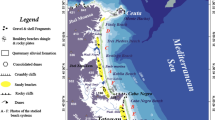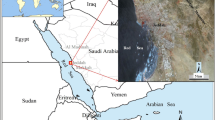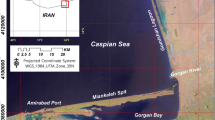Abstract
The variations in the lake area, water level, and water volume change of the Aral Sea from 1987 to 2018 were analyzed in this study, which is based on the multi-temporal Landsat images and remote sensing water body index (Normalized Difference Water Index, NDWI). Lake shorelines were automatically digitized and visualized using Net Shoreline Movement (NSM) and Linear Regression Rate (LRR) by Digital Shoreline Analysis System (DSAS). The surface area, water level, and water volume change of the North Aral Sea were not changed significantly in 1987-2018. The maximum lake area appeared in March 2015 with 3550.15 km2, the minimum lake area appeared in October 2001with 2830.56 km2. However, since 2010 the South Aral Sea split into the East Aral Sea and the West Aral Sea, the area change has shrunk dramatically. The area of the East Aral Sea decreased by 17852.65 km2 (89.99 %) from March 2011 to September 2018. The area of the West Aral Sea decreased by 2203.62 km2 (35.96 %) from August 2014 to March 2017. The distance of lake shoreline changes and rates of net movement along transects were determined by DSAS. The two largest positive values of NSM were 18715.93 and 12268.67 m, which showed lake shoreline retreat, occurred in the periods of 2010-2018 in the East Aral Sea and 1987-1999 in the South Aral Sea, respectively. The two periods in which the largest negative value of NSM appeared was (1987-1993) and (2001-2010) in the North Aral Sea, and the lake shoreline expanding distance was 145.43 and 545.84 m, respectively.










Similar content being viewed by others
Data availability
There are no linked research data sets for this submission.
References
Aladin NV, Gontar VI, Zhakova LV et al (2019) The zoocenosis of the Aral Sea: six decades of fast-paced change. Environ Sci Pollut Res 26:2228–2237
Aralgenefund (2011) Evolution of the Aral Sea. http://www.aralgenefund.org/eng/evolution/
Bai J, Chen X, Li JL, Yang L, Fang H (2011) Changes in the area of inland lakes in arid regions of Central Asia during the past 30 years. Environ Monit Assess 178(1–4):247–256
Berdimbetov T, Ilyas S, Ma Z et al (2021) Climatic change and human activities link to vegetation dynamics in the Aral Sea Basin using NDVI. Earth Syst Environ 5:303–318
Bosch K, Erdinger L, Ingel F, Khussainova S, Utegenova E, Bresgen N, Eckl PM (2007) Evaluation of the toxicological properties of ground- and surface-water samples from the Aral Sea Basin. Sci Total Environ 374:43–50
Cenci L, Disperati L, Persichill et al (2017) Integrating remote sensing and GIS techniques for monitoring and modeling shoreline evolution to support coastal risk management. Gisci Remote Sens 55(3):355–375
Chaudhari S, Felfelani F, Shin S, Pokhrel Y (2018) Climate and anthropogenic contributions to the desiccation of the second largest saline lake in the twentieth century. J Hydrol 560:342–353
Cretaux JF, Letolle R, Bergé-Nguyen M (2013) History of Aral Sea level variability and current scientific debates. Glob Planet Chang 110(11):99–113
Deliry SI, Avdan ZY, Do NT, Uğur A (2020) Assessment of human-induced environmental disaster in the Aral Sea using Landsat satellite images. Environ Earth Sci 79:471
Dewidar K, Bayoumi S (2021) Forecasting shoreline changes along the Egyptian Nile Delta coast using Landsat image series and Geographic Information System. Environ Monit Assess 193:429
Gaybullaev B, Chen SC, Gaybullaev D (2012) Changes in water volume of the Aral Sea after 1960. Appl Water Sci 2(4):285–291
Himmelstoss EA, Henderson RE, Kratzmann MG, Farris A (2018) Digital Shoreline Analysis System (DSAS) version 5.0 user guide. US Geological Survey, Reston
Izhitskiy AS, Zavialov PO, Sapozhnikov PV, Kirillin GB, Grossart HP, Kalinina OY, Zalota AK, Goncharenko IV, Kurbaniyazov AK (2016) Present state of the Aral Sea: diverging physical and biological characteristics of the residual basins. Sci Rep 6:23906
Krapivin VF, Mkrtchyan FA, Rochon GL (2019) Hydrological model for sustainable development in the Aral Sea Region. Hydrology 6(4):91
Krivinogov S (2014) Changes of the Aral Sea level. In: Micklin P, Aladin N, Plotnikov I (eds) The Aral Sea: the devastation and partial rehabilitation of a Great lake. Springer, Heidelberg, pp 77–111
Lioubimtseva E (2014) Impact of climate change on the Aral Sea and its basin. In: Micklin P, Aladin N, Plotnikov I (eds) The Aral Sea. Springer Earth System Sciences, vol 10178. Springer, Berlin
Lioubimtseva E (2015) A multi-scale assessment of human vulnerability to climate change in the Aral Sea basin. Environ Earth Sci 73:719–729
Loodin N (2020) Aral Sea: an environmental disaster in twentieth century in Central Asia. Model Earth Syst Environ 6:2495–2503
Mason IM, Guzkowska MAJ, Rapley CG, Street-Perrott FA (1994) The response of lake levels and areas to climatic change. Clim Chang 27(2):161–197
Massakbayeva A, Abuduwaili J, Bissenbayeva S et al (2020) Water balance of the Small Aral Sea. Environ Earth Sci 79(3):1–11
Matin N, Hasan G (2021) A quantitative analysis of shoreline changes along the coast of Bangladesh using remote sensing and GIS techniques. CATENA, 201 105185
Mcfeeters SK (1996) The use of the normalized difference water index (NDWI) in the delineation of open water features. Int J Remote Sens 17(7):1425–1432
Micklin PP (1988) Desiccation of the Aral Sea: a water management disaster in the Soviet Union. Science 241(4870):1170–1176
Micklin P (2004) The Aral Sea crisis. Dying and dead seas climatic versus anthropic causes. Springer, Dordrecht, pp 99–123
Micklin P (2010) The past, present, and future Aral Sea. Lakes Reserv Res Manag 15(3):193–213
Micklin P (2014) Introduction. In: Micklin P, Aladin N, Plotnikov I (eds) The Aral Sea: the devastation and partial rehabilitation of a Great lake. Springer, Heidelberg, pp 1–11
Micklin P (2016) The future Aral Sea: hope and despair[J]. Environ Earth Sci 75(9):1–15
Mullick MRA, Islam KMA, Tanim AH (2020) Shoreline change assessment using geospatial tools: a study on the Ganges deltaic coast of Bangladesh. Earth Sci Inform 13:299–316
Murat A, Kale MM, Tekkanat İS (2019) Assessment of the changes in shoreline using digital shoreline analysis system: a case study of Kızılırmak Delta in northern Turkey from 1951 to 2017. Environ Earth Sci 78:579
Peng Q, Wang R, Jiang Y, Li C, Guo W (2021) The change of hydrological variables and its effects on vegetation in Central Asia. Theor Appl Climatol 146:741–753
Sun FD, Ma RH (2019) Hydrologic changes of Aral Sea: A reveal by the combination of radar altimeter data and optical images. Ann GIS 25(3):247–261
Taube CM (2000) Instructions for winter lake mapping. In: Schneider JC (ed) Manual of fisheries survey methods II: with periodic updates. Michigan Department of Natural Resources, Fisheries Special Report 25, Ann Arbor.1-4
Thieler ER, Himmelstoss EA, Zichichi JL, Ergul A (2017) Digital Shoreline Analysis System (DSAS) version 4.0 — An ArcGIS extension for calculating shoreline change[M]
Yang X, Wang N, Chen A et al (2020) Changes in area and water volume of the Aral Sea in the arid Central Asia over the period of 1960–2018 and their causes. Catena 191:104566
Yue H, Liu Y (2019) Variations in the lake area, water level and water volume of Hongjiannao Lake during 1986-2018 based on Landsat and ASTER GDEM data. Environ Monit Assess 191:606
Yue H, Liu Y (2021) Water balance and influence mechanism analysis: a case study of Hongjiannao Lake, China. Environ Monit Assess 193:219
Yue H, Qian J, Li Y, Liu Y (2020) A new accuracy evaluation method for water body extraction. Int J Remote Sens 41(19):1–32
Yue H, Liu Y, Wei J (2021) Dynamic change and spatial analysis of great lakes in China Based on Hydroweb and Landsat Data. Arab J Geosci 14:149
Zavialov PO, Kostianoy AG, Emelianov SV, Ni AA, Ishniyazov D, Khan VM, Kudyshkin TV (2003) Hydrographic survey in the dying Aral Sea. Geophys Res Lett 30(13):1659
Zavialov PO, Ni AA, Kudyshkin TV, Kurbaniyazov AK, Dikarev SN (2009) Five years of field hydrographic research in the Large Aral Sea (2002–2006). J Mar Syst 76(3):263–271
Zhan S, Wu J, Jin M (2021) Hydrochemical characteristics, trace element sources, and health risk assessment of surface waters in the Amu Darya Basin of Uzbekistan, arid Central Asia. Environ Sci Pollut Res
Acknowledgements
The authors sincerely thank the National Aeronautics and Space Administration (NASA) and U.S. Geological Survey (USGS) for providing the Landsat data, and LEGOS/GOHS for providing the water level data. The authors would also like to thank the anonymous reviewers whose comments have greatly contributed to the improvement of this study.
Funding
The research is supported by the Natural Science Basic Research Program of Shaanxi (2020JM-514), the project of Shaanxi Coal and Chemical Industry Group (2018SMHKJ-A-J-03), and Xi’an University of Science and Technology (2019YQ3-04).
Author information
Authors and Affiliations
Contributions
Methodology and writing, H. Y., data curation, Y. L., modified the whole paper, H. Y., Y. L. and QY.W.
Corresponding authors
Ethics declarations
Conflict of interest
The authors declare no conflict of interest.
Ethical statement
All ethical practices have been followed in relation to the development, writing, and publication of the article.
Additional information
Communicated by H. Babaie
Publisher’s note
Springer Nature remains neutral with regard to jurisdictional claims in published maps and institutional affiliations.
Rights and permissions
About this article
Cite this article
Wu, Q., Yue, H., Liu, Y. et al. Geospatial quantitative analysis of the Aral Sea Shoreline changes using RS and GIS techniques. Earth Sci Inform 15, 137–149 (2022). https://doi.org/10.1007/s12145-021-00714-2
Received:
Accepted:
Published:
Issue Date:
DOI: https://doi.org/10.1007/s12145-021-00714-2




